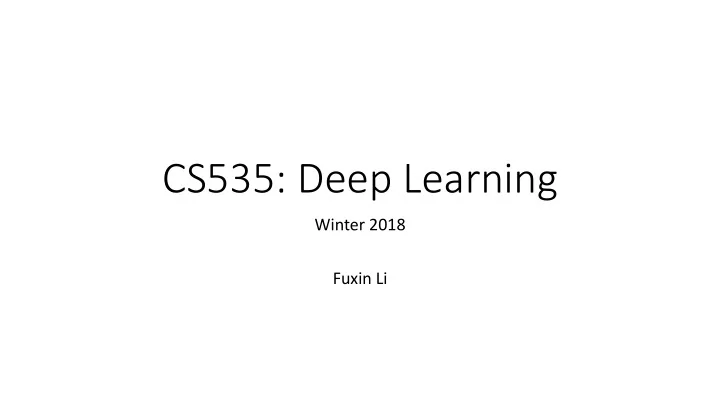

CS535: Deep Learning Winter 2018 Fuxin Li
Course Information • Instructor: Dr. Fuxin Li • KEC 2077, lif@eecs.oregonstate.edu • TA: • Xinyao Wang: wangxiny@oregonstate.edu • My office hour: TBD (vote) • Class Webpage: http://classes.engr.oregonstate.edu/eecs/winter2018/cs535/ • Questions/Discussions – on CANVAS
Prerequisites • Significant knowledge on machine learning, especially the generics (not specific algorithms) • CS 534 or equivalent knowledge • Refresher will be provided in the next lecture • Some knowledge of numerical optimization • 1.5 weeks will be devoted to optimization and also deep network optimization
Grading • Initial quiz (5%) based on participation only • 3 Assignments (30%) • Late assignments only on programming assignments (25% penalty for 2 days) • Must write your own code! • Quizzes (2 more quizzes totaling 20%) • Based on whether you answer the questions correctly • Final Project (45%) • Final project is to be done with teams not more than 3 participants • Grading will be done according to: • Initial proposal (10%) • Final oral presentation (10%) • Final written presentation (25%)
Materials • Book: • I. Goodfellow, A. Courville, Y. Bengio. Deep Learning. MIT Press 2016. • Electronic version: http://www.deeplearningbook.org/ • More readings can be found at: • http://deeplearning.net/reading-list/ • http://colah.github.io/ • http://karpathy.github.io/ • https://www.coursera.org/course/neuralnets
Toolboxes • A plethora of deep learning toolboxes around: • Caffe • Theano • Torch, pyTorch • TensorFlow • CNTK, MXNet, Lasagne, Keras, Neon, etc. • Toolbox policy: • We stick to pyTorch for assignments • Final project: select the one you are most comfortable with
Outcome • Understand the concepts of deep learning • Gain some intuitions on deep networks • Understand the training of deep learning • Be able to use at least one deep learning toolbox to design and train a deep network • Be able to design new algorithms and new architectures
What will be covered • Basic neural network structure • Training tricks (SGD, Momentum etc.) • CNNs • LSTMs • Unsupervised neural networks • Neural reinforcement learning (Dead week)
Final Project • Groups of no more than 3 persons • Jointly work on a significant project • Must use deep learning • CANNOT be just running an already-trained classifier on some images • Try to solve a real problem • One can elect projects from paper readings • I will try to suggest some standard projects • New neural architectures/changes to current architectures are welcome • Grading – based on the project merit, execution and presentation
Project Presentations • 2 presentations for the final project • Initial design (at least 1 month before finals week) • Talk about what is your project about • What you plan to do • Re-grouping if several people are thinking about similar projects • Final presentation (finals week) • Need to identify who did what in the team • 8 minutes per presentation • Slides uploaded to a common computer
Computing Resources • Pelican cluster: • 4 nodes with 2 GTX 980 Ti (6GB) each • Accessible by SSH at pelican.eecs.oregonstate.edu • Policy: 1 GPU per group otherwise risk your jobs be killed • If you want to buy your own: • Website will link you to a good article • GTX Titan V ($3,000!), GTX Titan X PASCAL, GTX 1080 Ti (Mar 2017), GTX 1080, GTX 1070 Ti ($450), GTX 1070, GTX 1060 (sorted descendingly by price)
Approximate schedule (will be on website) • Week 1 (Jan. 8 - 12) • 1. Admin + General Introduction + Machine Learning Refresher • 2. Optimization Primer #1 (nonconvex optimization, stationary points and saddle points, optima, gradients) + Basic 1 Hidden Layer Neural Network (backpropagation) • Week 2 (Jan. 15 - 19): Standard neural networks (MLK day break) • 3. Neural Network Optimization • Week 3 (Jan. 22 - 26): Convolutional Networks • 5. Theoretical Implications + Convolutional Neural Networks (mostly in computer vision) • 6. Continued CNN, Visualization of CNN • Week 4 (Jan. 29 – Feb. 2): Temporal Neural Models • 7. Temporal Neural Models (RNNs and LSTMs) • 8. Continued Temporal Neural Models (LSTMs, GRUs, stacked together with CNNs) • Week 5 (Feb. 5 – Feb. 9): Deciding what project to work on • 9. Introduction of deep learning toolboxes (Caffe, Keras, automatic gradients) • 10. An overview of other neural models • Week 6 (Feb. 12 - 16): Project proposals • 11. Project Proposals • 12. Neural Network Optimization (stochastic mini-batch gradient descent, momentum, dropout, learning rate and weight decay)
Approximate schedule • Week 7 (Feb. 19 - 23): Neural Network Optimization, Unsupervised Approaches • 13. Neural Network Optimization (stochastic mini-batch gradient descent, momentum, dropout, learning rate and weight decay, automatic step-size methods) • 14. Unsupervised Deep Learning (Autoencoders and variational autoencoders) • Week 8 (Feb. 26 – Mar. 2): Unsupervised Approaches • 15. Unsupervised Deep Learning II (GANs) • 16. ResNet and New Architectures • Week 9 (Mar. 5 - Mar. 9): Deep Learning Applications • 17. More applications • 18. Deep Learning in Natural Language Processing (Guest lecture from the Algorithms for Computational Linguistics group) • Week 10 (Mar. 12 - Mar. 16): Deep Reinforcement Learning • 19. Deep reinforcement learning (guest lecture by Alan Fern) • 20. Project Presentations • Week 11 (Mar. 19 - Mar. 23): Finals Week • 21. Project Presentations
Recommend
More recommend